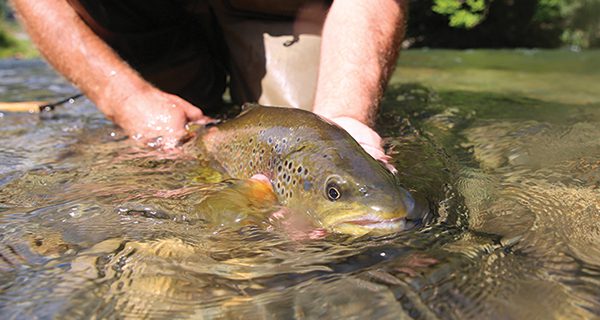Too many times to count, I’ve knelt in the shallows of a river or mountain stream, earnestly chanting, “Come on, buddy—come on, buddy.” No, I wasn’t trying to coax a reluctant retriever puppy into the water, though I’ve done that too. I was practicing a ritual, devoutly adhered to by millions of fishing brethren, the purpose of which was to preserve the fragile life resting in my hands. I had caught, so I had to release—alive and well, if at all possible. Lately, seems I’ve been pondering on that ritual more than ever.
I’m in my fourth decade now of doing this catch and release thing, having begun well before Brad Pitt fake-fished his way into cinema and angling history in the movie that made “fly fishing” virtually a household phrase (to be fair, it’s said that Mr. Pitt later became a pretty good angler.) So, I was an early true believer, including C&R in my largely self-administered fly-fishing education, much because it was the gospel being preached far and wide at the time. Resistors of the word, as it were, (and even the unenlightened) were but infidels to the purists and their followers. Self-righteous times, they were.
We fly fishing newbies embraced the idea and practice with little questioning, as the indoctrination was pretty intense. Fishing friends, guides and outfitters, magazines, TV shows, instruction schools, equipment makers—all were proselytizers. Now, all these years later and like many other anglers, apparently, I find myself drilling down on both the concept and its practice and examining more closely whether it is truly a good thing for fish and fishing itself.
Consider that when Lee Wulff, the legendary father of C&R, proclaimed, “Game fish are too valuable to be caught only once,” it was, after all, the 1930s, and the state of fishing and health of fish populations in America were very different from that of today. Something, many things actually, were needed then to counter the severe impact of extreme overharvesting, rapid industrial, residential and commercial development and massive pollution and degradation of streams, lakes and other waters. C&R, both deliberately and inadvertently, became one of various tools and practices that helped mitigate and reverse these impacts, particularly overharvesting, and ensure sustainability of affected fish populations.
There is little question that C&R has proved highly successful as a conservation mechanism. That success can easily be measured by the decades of increasing local, national and international awareness, interest, work and money, directed toward preserving specific fish populations and vital stream, river, lake and marine ecosystems (I, myself, was fortunate to be part of the successful and permanent preservation of a 10,000-acre Blue Ridge watershed that is a vital and historic brook trout fishery.) And, of course, the growth and success of conservation happened synergistically with the extraordinary growth of sport fishing and the massive industry and economy that came with it. For all of this, C&R was arguably a primary catalyst.
Fast forward to the present and we see the C&R waters seem to have gotten a little muddy, certainly on the ethical front and the ecological, economic and political as well. The phenomenal popularity of sport fishing (and fly fishing in particular), to which C&R has greatly contributed, is itself having an ecological impact on fish populations and habitats, which in turn, spurs those social and political controversies.
On many famous Montana trout rivers, for example, they call this problem of overcrowding and overfishing Rivergeddon. Where I live, the South Holston and Watauga Rivers often look like $500-a-boat theme park rides, minus the characters in goofy costumes (actually, they’re out there some, too).
Then there’s the serious ethical stuff, like whether fish feel the pain of the hook (science now says they do); or whether they are typically played and handled carefully enough to keep them from dying anyway after they’re released (up to 20% or more are not); or exactly why we play with fish, often to their distress and/or demise, and let ‘em go, but we don’t lasso wild deer, antelope or elk or pop turkeys and geese with paintball guns for our personal entertainment. Hmmm—want to tackle that one?
I didn’t write this piece to even pretend to have answers to the countless big questions swirling around C&R. But all the pondering I mentioned doing has helped me to answer perhaps the biggest question of them all. Namely, what would happen if we ended the practice of catch and release tomorrow? I’ll wager the answer will be obvious to you, too.
So… until somebody comes up with a legitimate, feasible scheme that can equal C&R’s incredible track record of global conservation success; keep bazillions of dollars flowing to conservation causes everywhere and tens, maybe hundreds of millions of people, worldwide, passionately engaged with the great outdoors—and defending it—I will continue to crimp my barb, play her carefully and swiftly when she strikes and go to her without letting her miss a breath. I will keep her and the ritual alive, if I possibly can.
David Arthur Ramsey is an outdoor photographer, writer and conservationist, born and raised in the mountains of northeastern Tennessee. His outdoor writing and photography have been published locally, regionally and nationally and are most often associated with work to preserve and protect threatened lands and waters throughout the Southern Appalachian Mountains.

